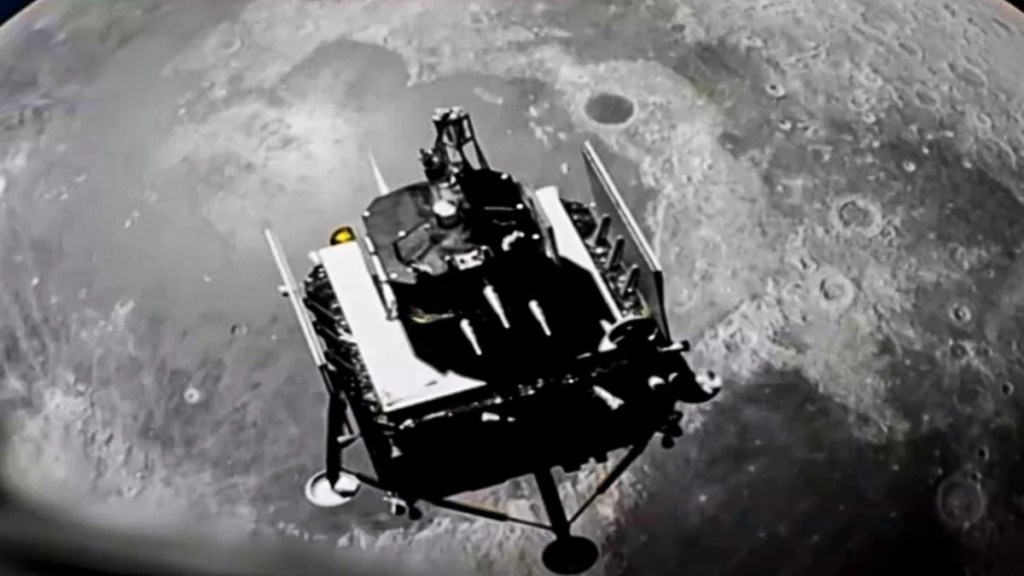The China National Space Administration (CNSA) has announced that the Chang’e-6 mission lander successfully landed on the far side of the moon on June 2, 2024 at 6:23 a.m. Beijing time (3:53 a.m. Indian time).
The lander touched down in the northeastern region of the South Pole-Aitken basin. Chang’e-6, named after the Chinese moon goddess, launched from the Wenchang spaceport in Hainan province on May 3.
Four days after launch, the 8.35-ton Chang’e-6 spacecraft entered lunar orbit. The spacecraft, which includes a lander, ascender, orbiter, and return capsule, had been orbiting the moon, searching for the ideal landing site and time.
On May 30, the lander and ascender detached from the orbiter and return capsule.
At 6:09 a.m. on Sunday, the lander activated its 7,500-newton-thrust engine to slow down and started its descent from around 15 km (9 miles) above the moon’s surface.
During the descent, the lander’s cameras took pictures of the landing area and sent them to its onboard computers. This helped identify potential hazards like large rocks, allowing the craft to manoeuvre and avoid them.
At around 100 meters (328 feet) above the moon’s surface, the lander paused its descent and hovered briefly to precisely detect smaller obstacles and choose the final landing spot. It then continued to descend at a slower, steady speed.
When the craft was just a few meters above the surface, it turned off its engine and gently landed on the moon, making China the only country to achieve a soft landing on the far side for a second time.
“Due to the communication delay between Earth and the moon’s far side, much of the landing process will be automated. However, Chinese engineers can still send instructions to the spacecraft through the Queqiao-2 relay satellite, which launched in March this year and is now orbiting the moon,” explains Bengaluru based Girish Linganna, Aerospace & Defence Analyst.
Uncharted Lunar Territory: The far side of the moon, often referred to as the “dark side” because it always faces away from Earth, is still mostly unexplored. Its unique geological features and isolation from Earth’s electromagnetic interference make it a perfect spot for scientific research, especially in astronomy and geology.
According to Linganna, missions to the far side of the moon face a significant challenge with communication because it is not in direct view of Earth. This problem is usually solved by using relay satellites, which help send data back to Earth.
Visible Moon Phenomenon: The reason we only see one side of the moon from Earth is due to a phenomenon called “tidal locking.” “This occurs when the gravitational forces between two celestial bodies, like the Earth and the Moon, cause one side of the smaller body (the Moon) to always face the larger body (Earth) as they orbit each other,” he adds.
For the Moon and Earth, these gravitational forces have synchronized the Moon’s rotation with its orbit around Earth. This means the Moon takes the same amount of time to rotate on its axis as it does to orbit Earth. As a result, we always see the same side of the Moon, known as the “near side.”
Adding, “The other side of the Moon, which we cannot see from Earth, is called the “far side” or “dark side.” However, this side is not always dark; it experiences day and night just like the near side. This tidal locking is why the far side of the Moon remains hidden from our view on Earth.”
Earth Return Capsule: The lander will use a robotic scoop and drill to collect rock and dust samples from the surface, digging about 2 meters deep to reach deeper deposits. It will take around two days (48 hours) to gather these samples.
After collecting lunar samples, the lander will transfer them to the ascender module. The ascender will then autonomously launch from the moon, taking a 6-minute flight to meet the orbiting module. The samples will be moved to a return capsule designed to safely re-enter Earth’s atmosphere.
If everything goes as planned, the return capsule will land on Earth on June 25, at the Siziwang Banner site in Inner Mongolia.

